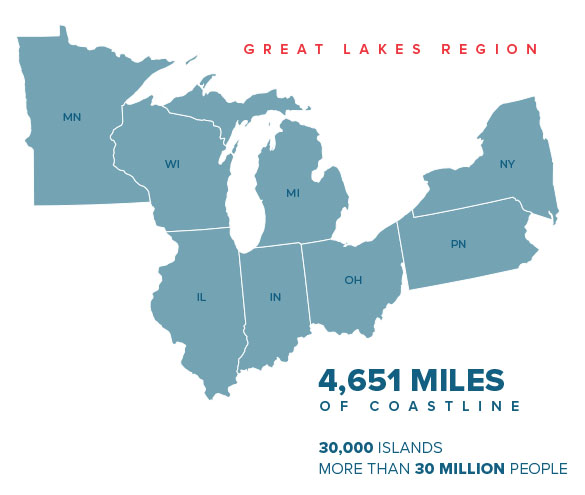Great Lakes Project Resources:

Invasive species cause ecological harm by displacing native species, degrading habitat and altering food webs. This, in turn, can negatively impact industries such as fishing, agricultural, and tourism, and can threaten human health.
The Great Lakes Basin provides drinking water, transportation, power, recreational activities, and over 1.5 million jobs. This precious resource has severely degraded over the years and is in need of immediate on-the-ground action. This region is the largest group of freshwater lakes on Earth; it holds 95% of the United States’ surface freshwater and has more than 4,650 miles of shoreline and 30,000 islands. More than 30 million people live in the area.
Aquatic invasive species can harm local water supplies, damage native ecosystems, impact outdoor recreation activities, and threaten our health and safety. They cost the U.S. billions of dollars annually to manage and can cause long-term economic and environmental harm.


Community volunteers coming together for a coastal restoration project in the Great Lakes region.

Common invasive species in the Great Lakes
The Great Lakes ecosystem has over 180 documented species of invasive and non-native species. It is extremely difficult to eradicate invasive species once they have become established. Early detection or prevention is much more cost-effective in controlling or preventing ecological and economic damage caused by invasive species. While invasive species in the Great Lakes include crustaceans, mollusks insects and algae, the majority, and most widely known, of these are fish and plants.
Species such as the Asian carp, zebra mussel, quagga mussel, round goby, sea lamprey and alewife are widely known as invasive. Some of the common plant species that are invasive in the Great Lakes include purple loosestrife, curly pondweed, reed canary grass, common reed (Phragmites), cattail, Japanese knotweed and Eurasian watermilfoil.
Invasive species and noxious weed classifications are very regionally specific. Sometimes, a plant classified as invasive in one area may not be invasive in another.


The best way for you to help prevent the spread of invasive plant species is to stop new outbreaks before they start. Each of us has a role in keeping our waterways clean and healthy for future generations. For example, the best way that you can help to prevent the spread of aquatic invasive species is to always clean your boat after use.
Early detection can help avoid many of the environmental and economic losses caused by invasive species. Reporting invasive species to the experts could stop the next invasion.
Report invasive species through the national Early Detection and Distribution Mapping System (EDDMapS) or the Great Lakes Aquatic Nonindigenous Species Information System
Additionally, many states have invasive species reporting hotlines, online forms, or mobile apps. Using your internet browser, search with the terms “invasive species reporting [enter your state or county]” to discover how best to report in your area.

While invasive species pose major challenges, a number of management options exist. Prevention is important, but that is beyond the scope of this website. Physical or mechanical control, chemical control, cultural management, and biological control are all useful tools.
Removing invasive species and restoring native species brings myriad benefits. Restoration of wetlands, dunes, and other coastal areas protects against erosion, reduces flooding, and improves water quality. Native birds, fish, and other wildlife return to restored areas, enhancing fisheries and biodiversity. Habitat improvement helps the recovery of threatened or endangered species. Tourism and outdoor recreation benefit as people fish, bird watch, or visit wildlife areas.
What can you expect if you want to remove invasive species?
Invasive species removal can be a rewarding activity for any group of concerned citizens. Many species can be removed by hand, with little training. It is best to consult a local expert to understand the likely long-term outcomes of your effort. Some plant species can only be substantially reduced using fire, changing land elevation, or applying herbicides across large areas, in accordance with permits. Some plant infestations are made worse by hand-pulling which can break the material into many pieces, each of which can sprout a new plant (e.g. knotweed) and can only be reduced with pesticides (permit required).
One important role for local residents is participating in identification efforts to stop the spread of these species before they firmly take hold.

North Carolina Environmental Quality


We need your help to improve the Toolkit by completing our easy, 3-minute survey. Your insight is valuable to us.